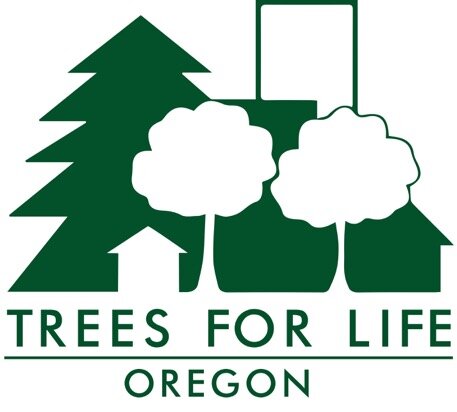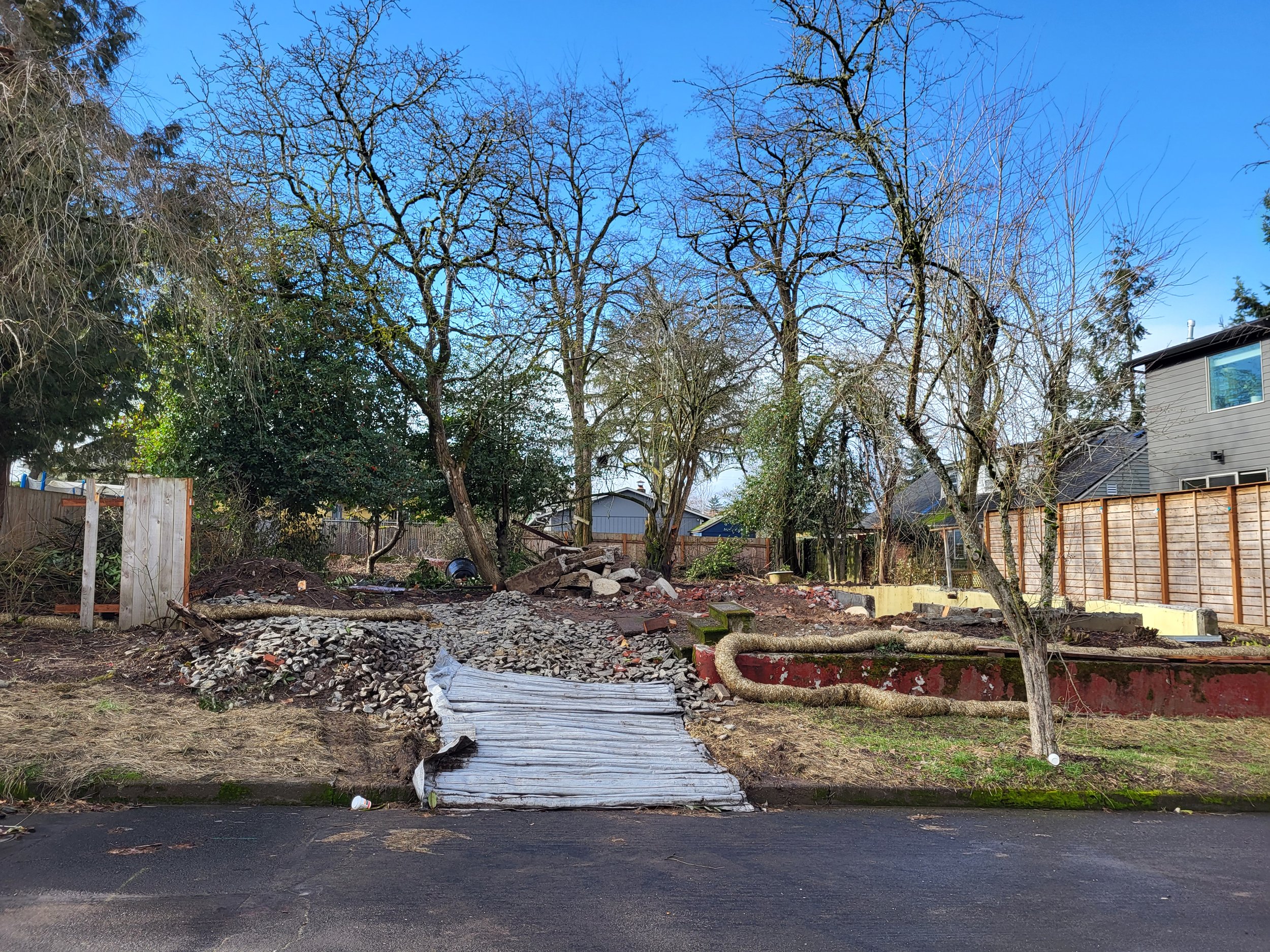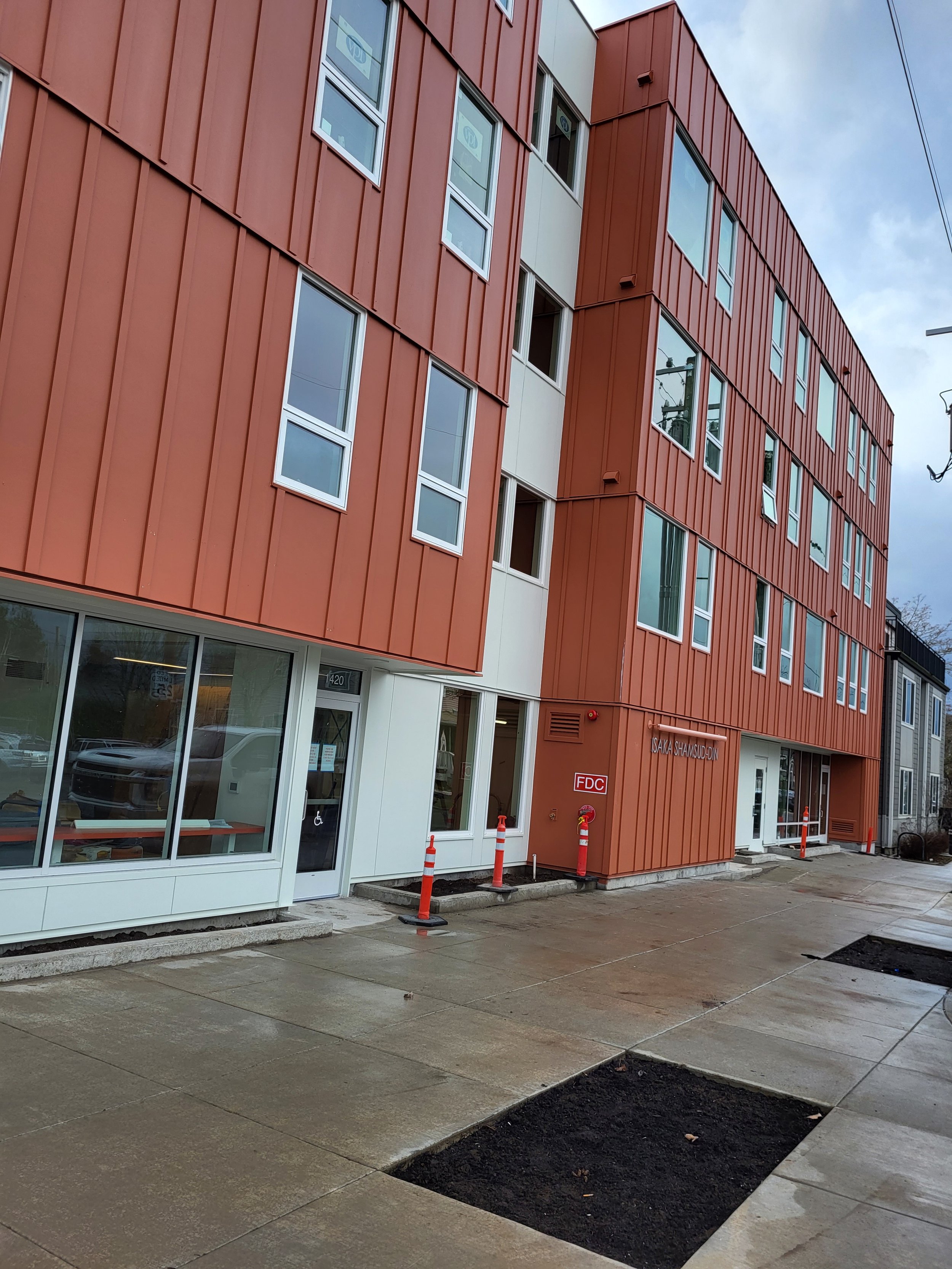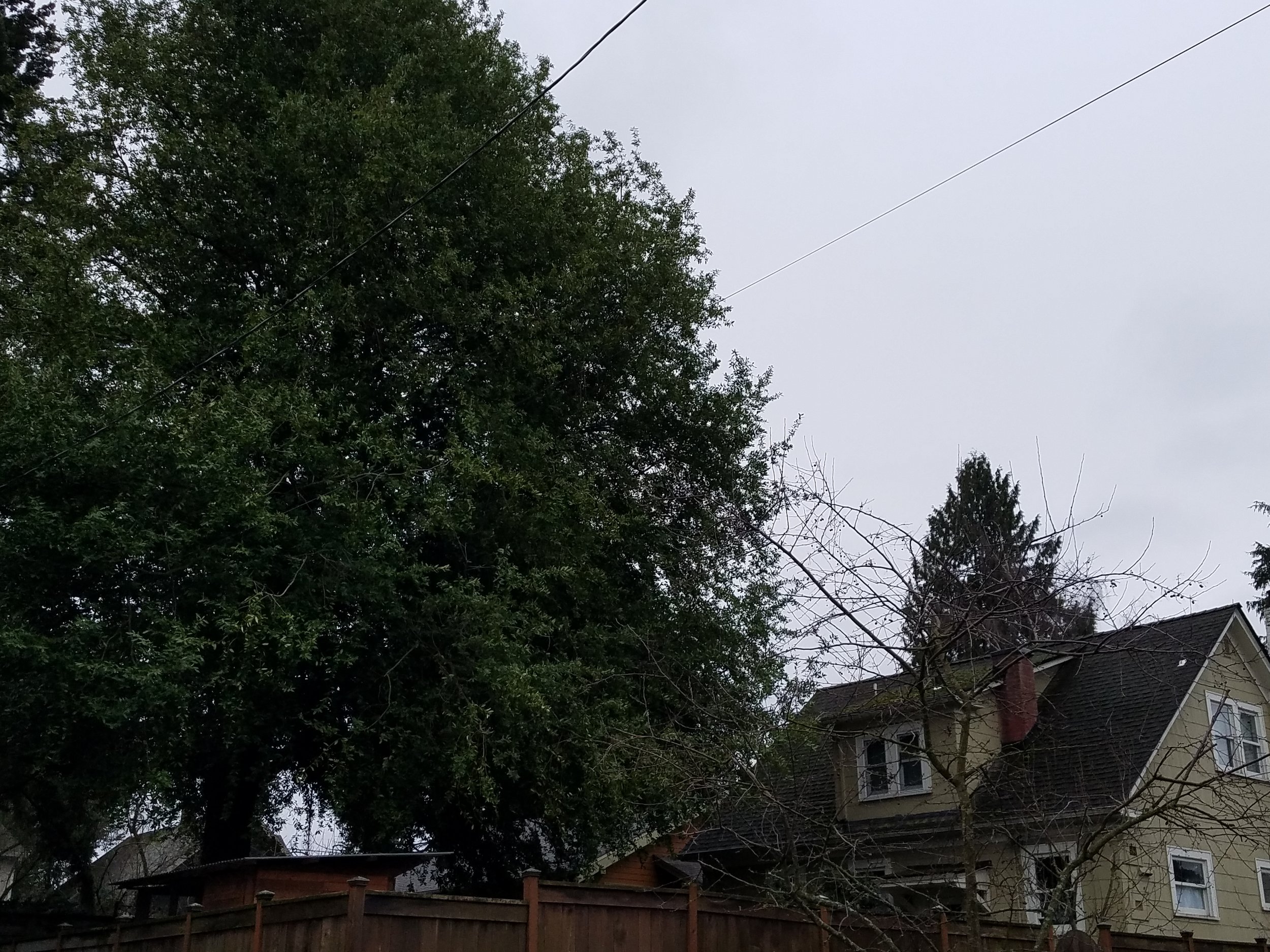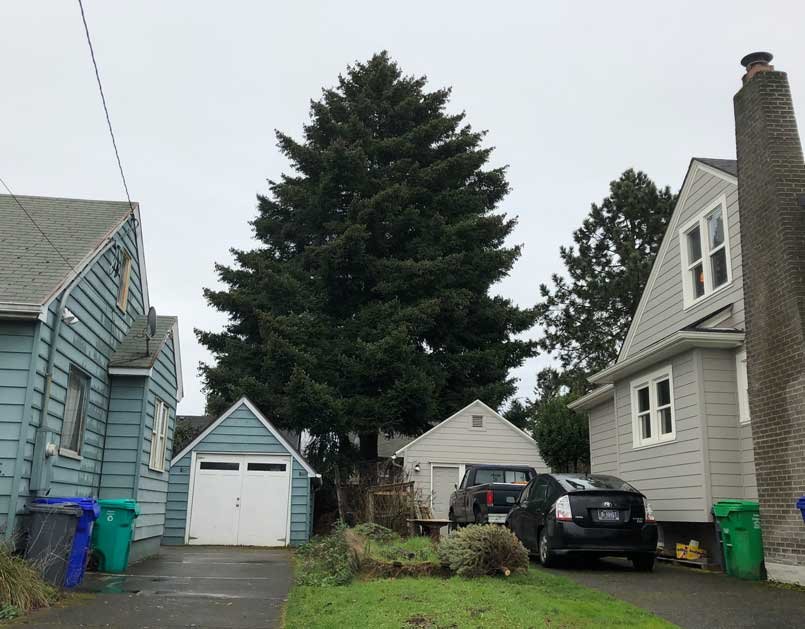Missed opportunity! These newer multi-family dwellings in north Portland have street trees but could have fit medium-size trees in their front yards. The absent trees would have shaded these homes and sidewalks on hot summer days. They could have been places for birds to roost and might have had nectar for pollinators or fruit and nuts to nourish wildlife.
The yards of newly built homes like this one in north Portland hold only small-maturing trees such as a Japanese maple or a dwarf conifer, even when there’s room for a medium-sized tree like a linden or Hungarian oak. The lack of dedicated arborist staff time within the Bureau of Development Services to ensure the best compliance with tree-planting regulations designed to maximize canopy is partly to blame.
The relatively low cost of smaller homes in north Portland makes them prime targets for purchase, demolition, and replacement by larger, more costly homes. That puts trees like this Douglas-fir at risk of removal unless the City puts more teeth into tree preservation rules. Social media short: North Portland Douglas-firs like this one are at risk of removal when standing next to small, lower-cost homes that are prime targets for development, unless the City puts more teeth into tree preservation rules.
The many young trees planted in front of this north Portland multiplex of necessity are small-maturing trees such as redbuds. By code, none could be planted in the narrow right-of-way planting strip, although ones that were already there were preserved. Would it have been better to forego the tiny strip of lawn in front of the buildings and instead place the sidewalk there, flush with the building, in order to create a much wider planting strip? That would have made enough space for a large-maturing tree that could have grown to shade this tall building. Adding a 5- to 6-foot sidewalk width to a 2- or 3-foot planting strip creates a space big enough for trees like lindens, elms, oaks, which live two or three times as long as redbuds. Rather than simply rubber-stamp plans that meet existing code, wouldn't it be better if City planners flagged developments where planting strips are narrow and worked with builders to create flexible solutions to creating optimal canopy outcome?
This north Portland multiplex has been around long enough to show what similar developments will look like in a few years. The driveways leave little yard space. Some residents have planted trees that, of necessity, are small at maturity. These cherries will barely be as tall as the roof. Limited private planting space is compounded by the narrow public planting strip. One solution is to shrink the front yard a bit and require wider street tree strips that can hold a larger tree. Right-of-way trees enjoy greater protection than private yard trees; they aren’t subject to removal at the whim of future homeowners as are yard trees within 10 feet of a house.
Another single-family home lies demolished in NE Portland. Developers often level all vegetation on a lot, paying whatever the fee is for removing large trees. But sometimes trees that should be removed are left. The hawthorn in this parking strip is in poor condition. It would be better to require the developer to remove it and replant with a healthier species after construction. Ditto the invasive English holly tree in the back left corner. Having a qualified City arborist review what trees are on lots as they come up for development would allow for such recommendations to guide what is preserved and what can and should be removed. The current state push to accelerate development by eliminating even the current, weak tree rules and practices we have now will further accelerate canopy loss in our neighborhoods.
This new multiunit on NE Killingsworth in Vernon has the expanded 9-foot-long tree wells required by updated codes. This still doesn't provide enough room for the healthy development of a large tree, and likely will result in its premature decline. Replacing trees periodically is more costly than designing enough space for them to begin with. Why not require a continuous planting strip, perhaps with stepping stones at intervals for pedestrians to cross, rather than isolate trees in what amount to large pots? This would also allow tree roots to intertwine below ground with those of other trees in the same strip, which researchers find can increase their resilience.
Under Portland's tree code, the magnificent blue Atlas cedar (at left) is not protected against removal by the property owner. That's because it’s growing within 10' of a structure, and City permits in that case are more or less automatically granted, no questions asked. As lots are redeveloped with narrower setbacks, almost all new yard trees will have to be planted within 10' of a structure, putting their long-term future in doubt.
These neighbors in Mt. Tabor share a healthy backyard western redcedar. The sale of either home to a developer could endanger this tree. Tree preservation rules don't even apply to average-sized and small lots, and where they do, developers can opt out of preserving a tree by simply paying a fee. Neighboring property owners have no legal say in what a developer may choose to do.
These young Oregon white oaks, likely planted by the Bureau of Environmental Services or Friends of Trees, are a great tree choice. But without City investment in planting strips, curbs, and sidewalks, soil compaction and vehicle damage--see skid marks here--put their long-term health and viability at risk.
One of East Portland’s distinguishing features is its impressive number of large Douglas-firs. Many of these second-growth trees are in the 75- to 100-year range and have withstood wind, snow, and ice while keeping neighborhoods like this one, Brentwood-Darlington, buffered from heat, noise, and pollution. But without thought given to preserving space for healthy big conifers where feasible, they could disappear within a generation. Many already have.
Big broadleaved evergreens like this Oregon myrtle (Umbellularia californica) gracing the backyard of a home in Rose City Park are rare in Portland. Native to coastal areas of southwest Oregon and California, these trees should be given extra consideration when development occurs because they provide the full array of environmental benefits year-round, something our more numerous deciduous trees can’t do in winter.
Many owners of new homes love nearby large trees. They park under their shade and enjoy the bird song these trees bring. Yet trees like this one may only be temporary. When the house on the left gets redeveloped, as the one on the right has been, will the developer preserve a mature shade tree like this one? This might require slight siting or floor plan changes, and adjustments cost. These adjustments were easier when planning to build a single-family home. When constructing a four-plex, now permitted in former single-family home zones, it’s much harder to make space for a decent-size tree, especially without requirements in code to do so.
This native western red-cedar in the front yard and these native Douglas-firs in the backyard could be preserved even if multi-use housing is built on this corner lot. It will take designing the units to protect enough space for their root zones. Currently, the City does not mandate that building designs be adjusted to preserve space for healthy, environmentally important species such as these.
Until they reach at least 20 inches in diameter at breast height, large-form trees like this backyard Douglas-fir receive no special protection. A tree's diameter at time of construction may not be the best gauge of whether it should be preserved. Without protecting younger trees of long-lived, large-growing species, neighborhoods will find themselves lacking replacements for their large-form trees as they die from old age.
It's rare to see a large-from tree planted in front of a new multi-unit building. Kudos to this developer, who planted oaks on three sides of this Arbor Lodge quadriplex with enough headroom to eventually shade the building. But to ensure these trees have enough room to reach their full size, a sand or gravel path or paving stones that could be adjusted as roots expand would have been a better solution.
Good tree choice but poorly sited! This narrow-form Alaska yellow-cedar is planted too close to the fence and sidewalk for its ultimate size. Placing it in the middle of the lawn would have allowed it to reach maturity without causing infrastructure problems. The right tree in the right space is paramount.
This grove of Douglas-fir sits on a corner lot in Arbor Lodge, the kind coveted by developers. Will space be provided for their continued existence once this home is sold and targeted for demolition so a multi-unit building can be erected?
Great that beautiful trees were squeezed into this small setback between buildings, but bad choice of species. Birches are highly vulnerable to death from the bronze birch borer. Portland Urban Forestry experts should have a greater say in approving tree choices in development. They can also check that the trees builders choose aren't just the cheapest available but are suited to the soil, drainage, available sunlight, and proximity of buildings.
This spruce on a corner lot faces an uncertain future. Its North Portland neighborhood is rapidly changing from one of modest, one-story single-family homes with many large shade trees to one of multi-story, multi-unit buildings lacking space for anything but small trees. Compared to this stately spruce, little trees will provide greatly reduced environmental benefits, not just to future owners of this lot but to everyone living on the block.
Corner lots are especially attractive to developers because of rules allowing greater density in neighborhoods formerly zoned for single-family homes. Without requirements to preserve large-form, healthy, non-nuisance trees when these lots are redeveloped, large trees are especially vulnerable to removal.
Multi-story apartment buildings are rising along transit routes across Portland, often abutting single-family neighborhoods. Existing large-form trees like this incense cedar are often the only big trees for several blocks. Apartment dwellers benefit in myriad ways from being close to this mature evergreen. But without strong rules to preserve healthy, non-nuisance, large- and medium-form trees, people living in these densely populated zones will be even further removed from nature.
Dawn redwoods (Metasequoia glyptostroboides) like this one are one of only five kinds of conifers that shed their leaves in winter. This living fossil, once thought to be extinct, was introduced to this country in 1948 after its discovery by Chinese botanists in China. Large trees like this one are at risk of extinction here, now that denser multi-unit development is allowed in residential neighborhoods formerly zoned as single-family. There is no blanket provision for their protection during infill development.
This large evergreen conifer gracing the backyard of a house for sale in NE Portland adds enormously to the livability of the neighborhood. As this kind of home is scooped up for redevelopment into duplexes and triplexes, ensuring firm rules to preserve space for these trees becomes essential.
